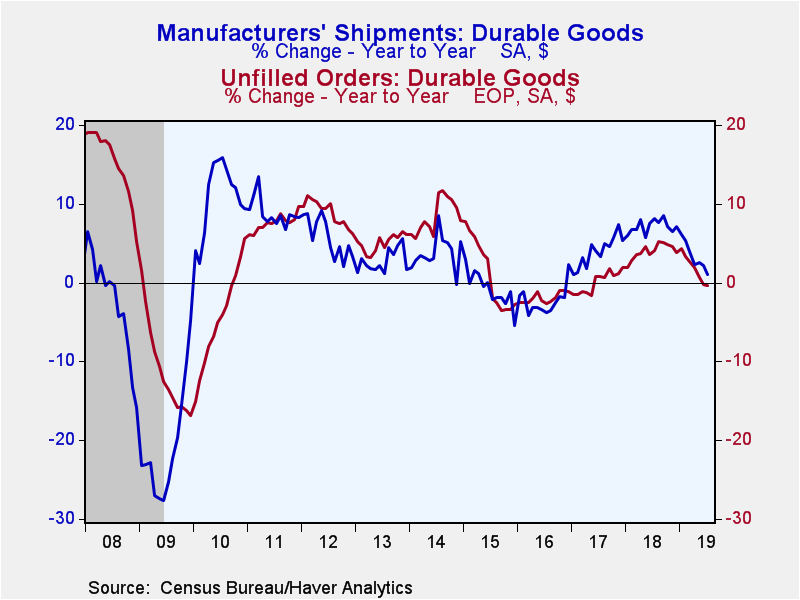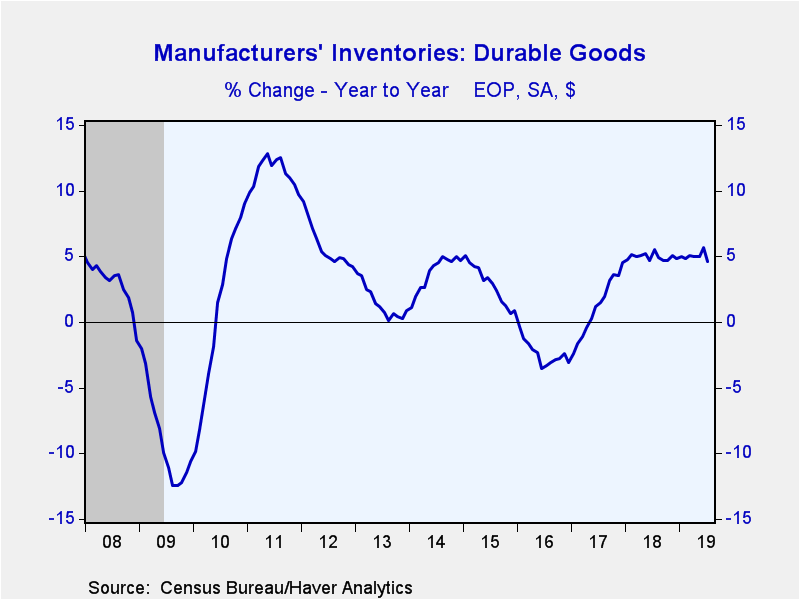 Global| Aug 26 2019
Global| Aug 26 2019Transportation Drives U.S. Durable Goods Orders Higher
Summary
Manufacturers' orders for durable goods rose 2.1% in July (0.7% year-on-year) following a slightly downwardly revised increase of 1.8% gain in June. The Action Economics Forecast Survey expected a 1.4% gain. Orders for transportation [...]
Manufacturers' orders for durable goods rose 2.1% in July (0.7% year-on-year) following a slightly downwardly revised increase of 1.8% gain in June. The Action Economics Forecast Survey expected a 1.4% gain. Orders for transportation equipment jumped 7.0% (2.3% y/y) powered by a 44.2% jump in volatile aircraft orders (-2.8% y/y); orders for motor vehicles increased 0.5% (3.8% y/y). Nondefense capital goods orders less aircraft, which is a forward-looking indicator of capital spending, grew 0.4% (-0.3% y/y), following a 0.9% increase in June. In the second quarter, inflation-adjusted non-residential fixed investment declined at a 0.6% annual rate (+2.7% y/y).
Excluding the transportation sector, orders declined 0.4% in June (-0.1% y/y). Defense aircraft orders fell 32.1% last month (-58.1% y/y). New orders for motor vehicles & parts improved 3.1% (7.6% y/y) following a 0.9% rise. Excluding the transportation sector, durable goods orders rose 1.2% in July (0.9% y/y) after a little-revised 0.5% gain.
Orders for nondefense capital goods recovered 4.8% (-6.6% y/y) and reversed June's decline. Nondefense capital goods orders excluding aircraft grew 1.9% (2.0% y/y) after a 0.3% rise, revised from 0.4%.
Elsewhere in the durable goods report, primary metals orders rose 0.8% (-6.1% y/y) and recovered June's decline. Orders for fabricated metals increased 2.1% (2.5% y/y), up for the third straight month. Orders for computers & related products rose 0.4% (3.7% y/y). Communication equipment orders jumped 4.0% (2.2% y/y), strong for a second straight month. Orders for computers & related products fell 1.8% (-3.3% y/y) after declining 3.2% in June. Orders for machinery improved 2.4% (0.9% y/y) after a 0.2% rise. Electrical equipment orders edged slightly higher (3.7% y/y) following five consecutive months of strong increase.
Shipments of durable goods increased 1.4% (2.7% y/y) following a 0.5% rise. Transportation sector shipments jumped 3.1% (3.8% y/y) and shipments excluding transportation gained 0.5% (2.1% y/y), about as they did in June. Unfilled orders for durable goods declined 0.7% (-0.3% y/y), down for the fourth month in the last five. Order backlogs excluding transportation rose marginally (1.3% y/y) after falling 0.2% in each of the prior four months. Inventories of durable goods increased 0.3% (5.7% y/y) following two months of stronger increase. Transportation sector inventories rose 0.8% (10.5% y/y) and added to earlier months' strength. Inventories excluding transportation have been unchanged for three straight months.
The durable goods figures are available in Haver's USECON database. The Action Economics consensus forecast figure is in the AS1REPNA database
| Durable Goods NAICS Classification | Jul | Jun | May | Jul Y/Y | 2018 | 2017 | 2016 |
|---|---|---|---|---|---|---|---|
| New Orders (SA, % chg) | 2.1 | 1.8 | -2.3 | 0.7 | 8.0 | 5.4 | -1.7 |
| Transportation | 7.0 | 4.1 | -7.5 | 2.3 | 9.9 | 3.2 | -0.6 |
| Total Excluding Transportation | -0.4 | 0.8 | 0.4 | -0.1 | 7.0 | 6.5 | -2.3 |
| Nondefense Capital Goods | 5.0 | 5.0 | -5.0 | 0.4 | 5.6 | 9.1 | -5.8 |
| Excluding Aircraft | 0.4 | 0.9 | 0.2 | -0.3 | 6.0 | 6.7 | -4.5 |
| Shipments | -1.1 | 1.0 | 0.5 | 1.1 | 7.1 | 4.0 | -2.3 |
| Unfilled Orders | 0.1 | -0.6 | -0.8 | -0.4 | 3.9 | 1.9 | -1.1 |
| Inventories | 0.4 | 0.3 | 0.5 | 4.6 | 4.8 | 4.5 | -3.0 |
Gerald D. Cohen
AuthorMore in Author Profile »Gerald Cohen provides strategic vision and leadership of the translational economic research and policy initiatives at the Kenan Institute of Private Enterprise.
He has worked in both the public and private sectors focusing on the intersection between financial markets and economic fundamentals. He was a Senior Economist at Haver Analytics from January 2019 to February 2021. During the Obama Administration Gerald was Deputy Assistant Secretary for Macroeconomic Analysis at the U.S. Department of Treasury where he helped formulate and evaluate the impact of policy proposals on the U.S. economy. Prior to Treasury, he co-managed a global macro fund at Ziff Brothers Investments.
Gerald holds a bachelor’s of science from the Massachusetts Institute of Technology and a Ph.D. in Economics from Harvard University and is a contributing author to 30-Second Money as well as a co-author of Political Cycles and the Macroeconomy.









